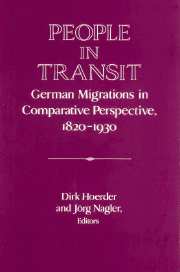Book contents
- Frontmatter
- Introduction
- PART I CONTINUITY AND COMPLEXITY: MIGRATIONS FROM EAST ELBIAN GERMANY AND GALICIAN POLAND
- Part II Internal German Migrations and In-Migrations
- PART III WOMEN'S MIGRATION: LABOR AND MARRIAGE MARKETS
- PART IV ACCULTURATION IN AND RETURN FROM THE UNITED STATES
- 18 Migration Past and Present - The German Experience
- 19 Research on the German Migrations, 1820s to 1930s: A Report on the State of German Scholarship
- Index
Introduction
Published online by Cambridge University Press: 05 January 2013
- Frontmatter
- Introduction
- PART I CONTINUITY AND COMPLEXITY: MIGRATIONS FROM EAST ELBIAN GERMANY AND GALICIAN POLAND
- Part II Internal German Migrations and In-Migrations
- PART III WOMEN'S MIGRATION: LABOR AND MARRIAGE MARKETS
- PART IV ACCULTURATION IN AND RETURN FROM THE UNITED STATES
- 18 Migration Past and Present - The German Experience
- 19 Research on the German Migrations, 1820s to 1930s: A Report on the State of German Scholarship
- Index
Summary
Germany is a country of emigration and immigration. The vast number of departures from port cities was obvious to any nineteenth-century observer. That the German states needed immigrants before the nineteenth century was also self-evident to mercantilist princes and their advisors. Accordingly, Huguenots as well as Salzburg and Bohemian Protestants were welcomed. Only in the twentieth century, or, to be more exact, from the 1880s onward, did attitudes toward in-migrants become ambivalent: Germany needed workers but did not want immigrants. Poles, Ruthenians, Italians, Belgians, and Danes were admitted only as “foreign workers.” While German emigrants to Russia, southeastern Europe, North and South America, and elsewhere were proud of their contributions to and economic achievements in other lands, emigrants from other countries to Germany were treated like pariahs, required to carry “legitimizing cards,” and forced to leave Germany every autumn. The situation improved after World War II, though in-migrants to Germany were never accepted in the same way as German out-migrants expected to be treated when they went abroad.
In the nineteenth century, Germany had high rates of internal migration. As a consequence, by the 1880s about one-half of the German population did not reside at its place of birth. Changes in agriculture as well as industrialization demanded migration - within a system of changing labor markets - to places where social life was not constricted by marriage regulations, remnants of feudal relations, or the absence of recreational possibilities.
- Type
- Chapter
- Information
- People in TransitGerman Migrations in Comparative Perspective, 1820–1930, pp. 1 - 16Publisher: Cambridge University PressPrint publication year: 1995
- 1
- Cited by



